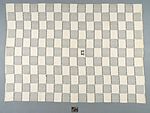Cloth
About this object
History of use
Cloths of this type are made by sewing narrow strips of woven cloth, selvedge to selvedge. They are used throughout west Africa for clothing, ground cloths, covers, tent subdividers, and for other purposes. The cloth strips are woven by men on double-heddle looms. In the country, cloth is woven mostly from hand-spun cotton, spun by women on drop spindles. Patterns, colour, representations, and the number of stripes traditionally had religious and status significance. Different cloths were used for different occasions, and by people with varying status. Traditionally the patterns had names and specific meanings, which have now been mostly lost.
Narrative
The De Wreede collection was collected over a 2 year period in which the De Wreede's were mostly in Sierra Leone, and partly in Nigeria.
Cultural context
clothing; furnishings
Physical description
Rectangular cloth consisting of eleven narrow, 12.5 cm woven cloth strips, sewn selvedge to selvedge. Pattern is a checkerboard of 12.5 cm by 10.5 cm of black and white squares, 1 cm by 0.5 cm stripes of alternating black and white, creating a plaid type weave. 1.5 cm white fringe at both ends. Diamond design off centre. Many stains. Generally loosely sewn at selvedges, and missing between 5th and 6th strips, from left side on one end. There is a pull in the weave 58 cm from same end, 35 cm from right side.
Categories
Materials
Date Made
Before 1981
Date Acquired
8 Jan 1982
How Acquired
Donated
Credit Line
Measurements
Overall: 195.1 cm x 138 cm
Object Number
Af507
